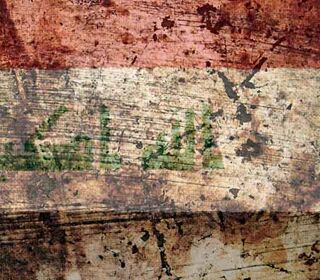
Blog

On the 20 of March 2003, 'Operation Iraqi Freedom' was launched. Its aim - to free the Iraqi people from the tyranny and brutality of Saddam Hussain.
By Dr Lily Hamourtziadou (Lecturer in Security Studies and Principal Researcher of Iraq Body Count) and Edwin Knapp (third year Criminology student).
The 3 phased operation was supposed to be simple, efficient, and surgical. Phase 1: deter; phase 2: seize initiative; phase 3: dominate. During his election campaigns, US President Bush had made it clear that under his leadership the US would limit its global interventions. However, even though these may have been his initial intentions, Bush showed that he was willing to change his philosophy and security policy for what he saw as ‘the greater good’.
It can be argued too that the invasion would have happened regardless of 9/11 seeing that the US had already sustained a steady flow of air-strikes and conflicts with Iraq for the prior 2 decades more or less, the 2003 invasion was more or less an inevitable eventuality.
Al Qaeda slamming two American airlines into the World Trade Centre towers and hijacking another two, one of which crashed on the Pentagon, causing the deaths of nearly 3,000 civilians, was the major trigger for the conflicts that would unfold in Iraq in 2003. The world hegemon, which no state would dare to fight, was attacked.
Amid the chaos and the fear generated by the September 11 attacks, a great amount of information and reports of threats against the US and the Western world from the Middle East flooded in. One of the major concerns was potential nuclear terrorist attacks, as rogue states would fund and supply terrorists with the necessary resources. However strong or reliable those reports were, Bush ordered his war council to prioritise this threat above all others. In November 2001 he stated that he would pre-emptively strike anyone who might use nuclear weapons against the USA. This opened the door to an aggressive foreign policy, which allowed Bush to ‘justifiably’ launch Operation Iraqi Freedom.
Four months after the attacks, on January 29th 2002, in his State of the Union address, Bush identified an Axis of Evil: Iran, North Korea and Iraq. The governments of those states, according to him, sponsored terrorism and were developing weapons of mass destruction, thus threatening the security not only of the USA, but the rest of the civilised, free, democratic western world. He criticised Iraq the most:
"Iraq continues to flaunt its hostility toward America and to support terror. The Iraqi regime has plotted to develop anthrax and nerve gas and nuclear weapons for over a decade. This is a regime that has already used poison gas to murder thousands of its own citizens, leaving the bodies of mothers huddled over their dead children. This is a regime that agreed to international inspections, then kicked out the inspectors. This is a regime that has something to hide from the civilized world."
In response, the UK, under the leadership of PM Blair, released the famous dossier that claimed Saddam had chemical and biological weapons and was working towards a nuclear capability, despite the fact that the UN’s Monitoring, Verification and Inspection Commission carried out over 700 inspections between November 2002 and March 2003, none of which found WMDs.
On the 20th of March 2003 the US-UK coalition commenced the invasion of Iraq, during which over 7,400 Iraqi civilians were to lose their lives (Iraq Body Count).
Just prior to the invasion, on March 17th, Bush in a speech had stated that:
"The regime has a history of reckless aggression in the Middle East. It has a deep hatred of America and our friends. And it has aided, trained and harboured terrorists, including operatives of Al-Qaeda."
The only truth in that statement lay in the ‘reckless aggression’ Saddam Hussain had shown in attacking Kuwait, which first made him a threat to Western interests in the Middle East. Years earlier, when his regime was fighting a war against Iran, during which he is said to have caused the deaths of thousands of Kurdish civilians in Iraq, Saddam was very much a friend and ally of the West and his ‘reckless aggression’ did not bother either the American or the British leaders. If anything was ever evidence of an interest-led foreign and security policy, completely devoid of morality or consideration given to foreign civilians, that was it.
Iraq went from having a total of 5 violent deaths in January and February 2003, to 3,977 civilians deaths in March alone, as a result of the US-led ‘Shock and Awe’ (Iraq Body Count). These numbers would rise over the following decades, totalling a minimum 206,000 civilian deaths 16 years on. During the initial months of the conflict, most civilian deaths were a result of coalition aggression; as Shock and Awe ended, the violence that followed it came both from the coalition and from insurgency, with terrorism added soon after.
The killings were committed by many different perpetrators and by a variety of methods; coalition forces, insurgents, terrorists, American soldiers, British soldiers, Sunnis, Shia have brought about the death of innocents through air strikes, suicide bombings, car bombs, shootings, IEDs… The victims, people from all walks of life: shepherds, street cleaners, construction workers, policemen, doctors, clerics, teachers, journalists, politicians, school children… Killed as they walked, shopped, worked, drove, slept, changed a tyre…
Thousands of civilians have been killed each year, since the night of the flashing images. At its peak, the terror claimed 29,027 in 2006; at its calmest, 3,319 in 2018.
Civil war followed the 2003 invasion, as the fragmented Iraqi society started to further divide and as the cracks deepened. Alliances started to form against perceived enemies, on the basis of religion, political affiliation and ideology. Organised groups struggled to gain power over others to achieve independence and, later, to change government policies or to overthrow it, as the grievances increased. It was in 2006 and 2007 that Iraq experienced its highest levels of sectarian violence, when the fighting between Sunni and Shia peaked. The insurgency was to last to the present day.
Iraqi insurgency has taken several forms. It has been a fight again the occupying forces, a fight against the Iraqi government, as well as a fight against another faction, or even against former members of the same faction, as in the case of Sunnis who sided with US forces in 2008, during the “Sunni Awakening.” In short, those seen as either terrorists, or collaborators, or both. Following the American withdrawal in December 2011, a renewed wave of sectarian and anti-government insurgency swept Iraq, raising fears of another civil war.
There have been perhaps as many as 40 different armed groups, but the major groups of armed insurgency have been:
- Ba'athists, supporters of Saddam Hussein's administration, including army or intelligence officers, whose ideology is a variant of Pan-Arabism. Their goal was the restoration of the former Ba'athist government to power, and later joined forces with guerrilla organisations that opposed the U.S.-led invasion. They are increasingly under Syrian influence.
- Iraqi nationalists, Iraqis who believe in Iraqi self-determination and advocate the country's territorial integrity. They also rejected the presence of the coalition forces and took arms against them.
- Sunni Islamists, Salafi/Wahhabi “jihadists.” Salafis advocate a return to a strict understanding of Islam and oppose any non-Muslim groups and influences, and regularly attack the Christian, Mandean and Yazidi communities of Iraq. They also attack Shia Muslims, whom they consider apostates.
- Shi'a militias, including the Iran-linked Badr Organisation and the Mahdi Army. Shia Islamists are thought to be Iranian-run groups, influenced ideologically and armed by Iran. The Badr Organisation was formed by the Iranian Government to fight the Saddam Hussein-controlled Iraq during the Iraq-Iran War 1980-88. Following the 2003 invasion, they moved back to Iraq, from Iran, to fight alongside the US-led forces against other insurgents. They now support the al-Maliki government. The Mahdi Army was made up of supporters of Muqtada al-Sadr. They were the first serious opposition to the US-led coalition from the Shia community and fought against the occupying forces for the next 5 years. At his most popular, Al-Sadr had the support of 68% of Iraqis, according to a poll by the Iraqi Centre for Research and Strategic Studies, as he fought to liberate Iraq. The Mahdi Army was also thought to have been trained by Iran: "There seems to have been a strategic decision taken sometime over late winter or early spring (of 2006) by Tehran, along with their partners in Lebanese Hezbollah, to provide more support to Sadr to increase pressure on the U.S.," according to a senior American intelligence official (New York Times 2006).
- Foreign Islamist volunteers, including those often linked to al Qaeda and largely driven by the Salafi/Wahhabi doctrine. They are mostly Arabs from neighbouring countries, Syria and Saudi Arabia primarily, Wahhabi fundamentalists who wish to assist the insurgency against western forces and their allies in Iraq. They are fighting a jihad under the ideological umbrella of Al-Qaeda and Ansar al-Islam.
The warring parties, including the US-led coalition forces and the current Iraqi government forces, have acted to and claimed to: liberate, occupy, subjugate, control, defeat, avenge and defend -territories (the Iraqi state, or parts of it), people (the Iraqis, or various religious and ethnic groups within Iraq) and values (western, muslim, democratic, national).
Meanwhile Iraq was “liberated” and “democratised,” with elections taking place during the years of occupation. As the killing continued. After the initial drop in civilian deaths around 2011, when US troops withdrew, they again started to rise in 2014, when ISIS gained control and territory. From 500 civilian deaths a month, we see a rise to 1,000 per month, and then a gradual increase to around the 1,500 per month mark, with a peak in June 2014 of 4,000 deaths. Throughout 2014-2017, ISIS were responsible for more or less half of all the civilian deaths reported. The rise of ISIS then saw the re-introduction of Western coalition airstrikes. The airstrikes only added to the civilian casualties and property damage, further driving Iraq as a country into the ground.
The core of security, the protection from harm, assumes a field of relationships, including a threatener, the threatened, the protector or means of protection, and the protected.In today’s Iraq the blurring of the lines between war and peace, tyranny and democracy, freedom and oppression has resulted in confusion as to who is threatened, who is the threat, who is the protector and what the means of protection are. The relationships between protector and protected, threatener and threatened, are in disorder.
The impact of those four planes that launched an assault on America in September 2001 has been more than the deaths of 3,000 civilians. It is the legacy of death, fear and insecurity that afflicts the lives of Iraqis to this day. Operation Iraqi Freedom may have been more aptly named Operation Iraqi Terror.
As the War on Terror reaches its 18th year, what have we achieved, other than the (sometimes successful) battling for our interests on the soil of those weaker than us?
Although plans and money is funnelled into Iraq to rebuild the infrastructure, it does not repair the psychological and emotional damage to the civilian population. It does not repair the emotional turmoil of lost family and friends. No money can repair such damage, and such damage will be ever present for generations to come. Ultimately, The War On Terror and ‘Operation Iraqi Freedom’ only plunged Iraq into the ground, and led to the events which have so far claimed the lives of over 206,000 Iraqi civilians.




